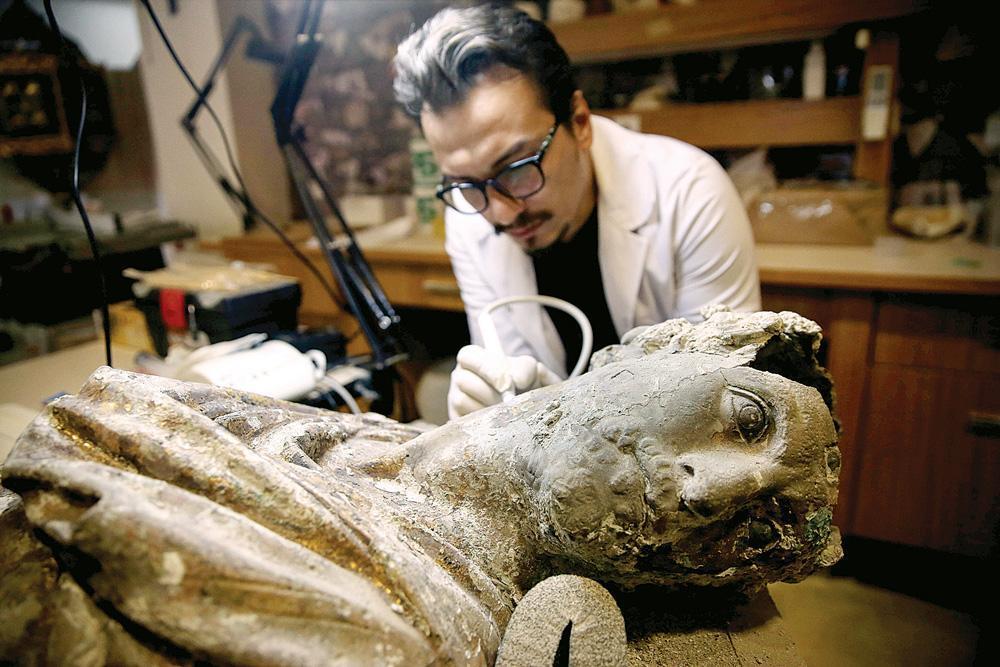
The restoration team at the Directorate of Istanbul Central and Regional Restoration and Conservation Laboratory, work delicately like surgeons to restore and conserve artifacts from various civilizations that belong to Turkey’s historical heritage.
Established in 1985 for the protection of the country’s historical artifacts, the laboratory started out with a team of 25. After a law passed in 2012, nine regional laboratories were opened, making them more effective.
The lab currently consists of a team of 84, including 62 restorers and geology, physics, environmental and metallurgy engineers. The engineers conduct analyses in the lab while the restorers work to restore artifacts.
The other regional labs are in Ankara, Antalya, Bursa, Diyarbakır, Erzurum, Gaziantep, İzmir, Nevşehir and Trabzon. The regional labs work on the conservation of artifacts in museums in their own cities and carry out periodical checks at the museums.
Speaking to Anadolu Agency, Istanbul Central and Regional Restoration and Conservation Laboratory Director Ali Osman Avşar said their main purpose was to align their work according to international scientific criteria.
Therefore, all personnel have been trained with this in mind and are provided lab equipment based on this criteria, adding that they were equal to the labs in many European countries or a step ahead of many others, he said.
Avşar said the lab experts have been encouraged to take post graduate studies. “The better the quality of the personnel, the better the quality of the work,” said Avşar. “Our aim is to carry out the restoration work in our country, which is rich in historical artifacts, as best as possible based on scientific criteria and to create a Turkish school in the field of restoration.”
More than 30,000 artifacts in three years
The director said that after the opening of the regional laboratories, 32,000 artifacts had been restored out of 3.5 million registered artifacts in the museums in three years, which is a good number for newly established labs.
“Every intervention is very important. There is no turning back from a mistake in the restoration. Therefore, very careful study is required. Before the work, the identification, documentation and detection of the material in your hand must be done very well. For that reason, the 13 engineers in our laboratory analyze all of the material before the restoration,” Avşar said, stating that restoration and conservation require patience and time and should be done with care.
He pointed out the importance of using devices for advanced technical analysis in the labs, especially to carry out analyses without using destructive methods. “Most of the time, it is impossible to take a piece from a historical work and analyze it. But this is possible with non-destructive analyzing tools. We prefer devices that can conduct a non-destructive analysis. We prefer to invest in such tools as often as possible.”
Avşar said the laboratories also carried out restoration projects in vast ancient sites and historical fields in the country. He also said they had carried out the restoration-protection projects of the Mount Nemrut sculptures and the wall paintings in the Sümela Monastery, Göreme, Ürgüp, Cappadocia and Milas burial chambers. Their recent project was the protection and restoration of the Ahlat Seljuk tombstone, he said.
Special tool for Yenikapı findings
Tools have been bought for the restoration of 8,000 small underwater findings, said Avşar. “Currently, an area is being prepared for where the tools will be installed. We will start the conservation of these findings in two to three months. These artifacts are kept in bowls with special water, which is changed periodically,” he said.
He said they also carry out replica projects, adding that they have made a replica of the tomb of Alexander the Great, which is in the Istanbul Archaeology Museums and which has been on display at a museum in Macedonia.
He said every work has been documented in an archive, especially the tiles in Istanbul mosques, which have been numbered one by one in a catalogue.